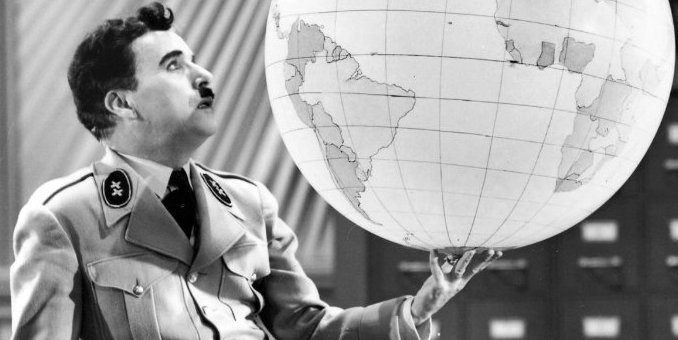
As the 1930s were coming to a close and the clouds of war spreading across Europe, Hollywood studio executives were keeping a wary eye on the situation. War, and the subsequent loss of several territories in which they could distribute their films, could be very bad for business. The studios were loathe to openly criticize the rising Third Reich and its leader Adolf Hitler, even if the Production Code and isolationist politicians weren’t encouraging them to do just that. But many in the executive suites in Hollywood were either immigrants and first generation Americans who still had relatives back in the old country, and were hearing troubling news about what was happening in Germany. Ultimately, it would be Jack Warner at Warner Brothers Studios who would break the silence over the growing Nazi threat in Europe, ordering into production Confessions Of A Nazi Spy, based in part on the true story of the Rumrich Nazi spy case in which 18 people were caught by the FBI and indicted on charges of spying for Nazi Germany. Production Code Administrator Joseph Breen, a noted antisemite, expressed concerns to Warner Brothers about the film specifically referencing Hitler. Ultimately, the film was passed for release by the Production Office and became not just a hit for Warners, but an important early step in Hollywood’s contribution to the war effort – propaganda films that helped to lift the morale of those on the home front, encouraged participation in efforts to help the war effort and showed the Axis powers in a less than flattering light. As part of that flood of propaganda entertainment were a number of comedies, both live action and animated, many of which held up the Fuhrer himself as the object of ridicule. Here are some of the best examples of the films that mocked Hitler from that era.
You Nazty Spy!
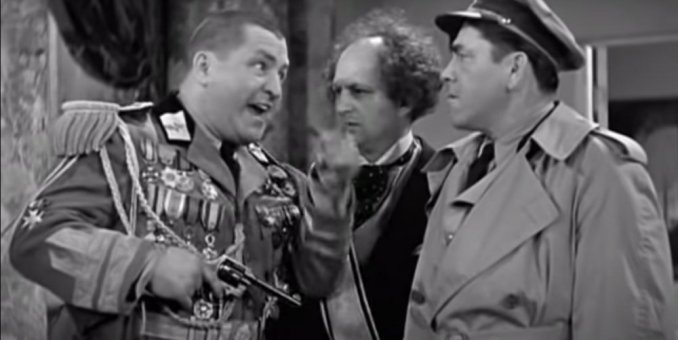
With permission to openly criticize Adolph Hitler and the Nazis seemingly given by the positive reception for Confessions Of A Nazi Spy, the first to jump at the chance to hold them up to mockery turned out to be the Three Stooges, with the release of their short You Nazty Spy! on January 19, 1940. The eighteen minute runtime of the short sees Moe, Larry and Curly become enmeshed in a plot that sees them become the rulers of the country of Moronica with the three mirroring the likes of Adolf Hitler, Benito Mussolini and Hermann Goring. While the Hays Code discouraged feature films from containing overt political messages that might not treat rulers of other countries fairly or respectfully, sShort subjects like the Stooges’ output never came under the same scrutiny. You Nazty Spy! would be another voice arguing against American isolationism as it became more apparent that Europe was about to be engulfed by war.
The Great Dictator
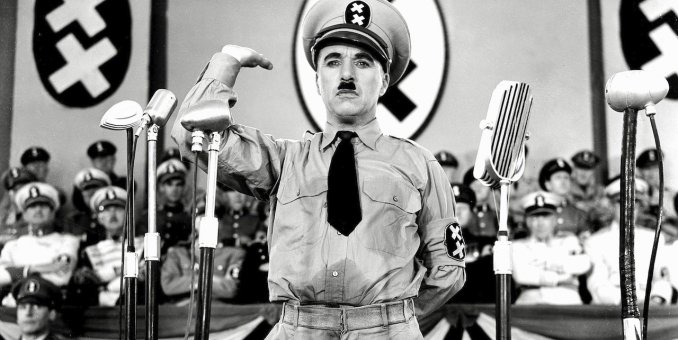
Perhaps the most famous of all the Hitler-themed comedies, Charlie Chaplin’s The Great Dictator centers on a Jewish barber who gets mistaken for despotic ruler Adenoid Hynkel, a very obvious Adolf Hitler analog, in this riff of Prisoner Of Zenda. Although he had been planning the film for a number of years, Chaplin began production on the film in September 1939, just as Hitler’s blitzgrieg was sweeping across Poland. The film would prove popular with both audiences and critics, with critical assessment in the decades after its release deeming it not only one of the best comedy films of all time but an important work of satire as well. It was nominated for five Academy Awards including Outstanding Production, Best Actor and Best Writing (Original Screenplay) and placed on the Library of Congress’s National Film Register in 1997.
To Be Or Not To Be
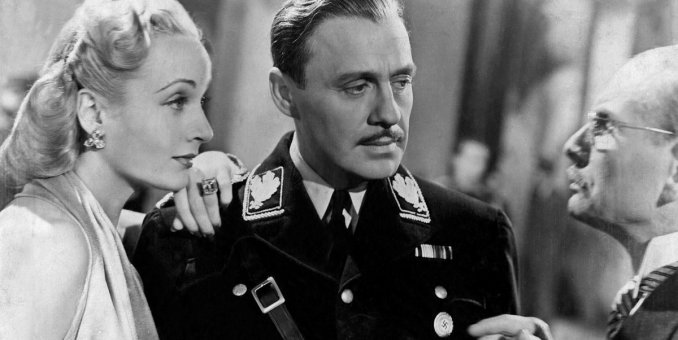
While it seemed OK for someone like the Three Stooges or Charlie Chaplin to make fun of proxy Hitlers, specifically referencing him as director Ernst Lubitsch did in his comedy To Have And Have Not seemed in much more questionable taste in the first early months of America’s involvement in World War Two. At least that was the reaction from some critics, such as The New York Times‘s Bosley Crowther who wrote that it was “hard to imagine how any one can take, without batting an eye, a shattering air raid upon Warsaw right after a sequence of farce or the spectacle of Mr. Benny playing a comedy scene with a Gestapo corpse. Mr. Lubitsch had an odd sense of humor—and a tangled script—when he made this film.” The Mr. Benny in question was Jack Benny, the country’s biggest radio comedian, who starred in the film as the head of a Polish theatrical company trying to escape the Nazi occupation. But try as they might to escape, they find themselves drawn into a plot involving captured Allied secrets with a member of the theatre company’s resemblance to Hitler factoring into the finale. More modern reappraisals have praised the comedy for its satiric bent and Lubitsch’s ability to find the humor in the situation his characters were in without ever trivializing the real danger.
Blitz Wolf
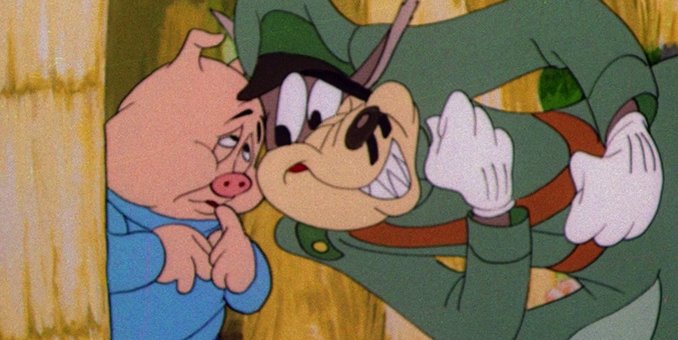
Tex Avery established himself at the Warner Brothers animation division as a director with a wild, anarchic style that never failed to get laughs. When he moved over to rival studios MGM at the end of 1941, his style blossomed even further, right from the start with his first short for the studio Blitz Wolf. A riff on the classic Three Little Pigs fairy tale, the Big Bad Wolf becomes Adolf Wolf, who has plans to invade the pig’s nation of Pigmania. The cartoon also works as a bit of political commentary as the two pigs who built their houses of straw and sticks state they don’t have to build defenses against Adolf Wolf as they signed a non-aggression pact with him. Needless to say, the wolf ignores such an agreement. Surprisingly, though, despite the film’s virulent message, it would be the only cartoon in MGM’s 1942 animated output that would address the burgeoning war.
The Devil With Hitler
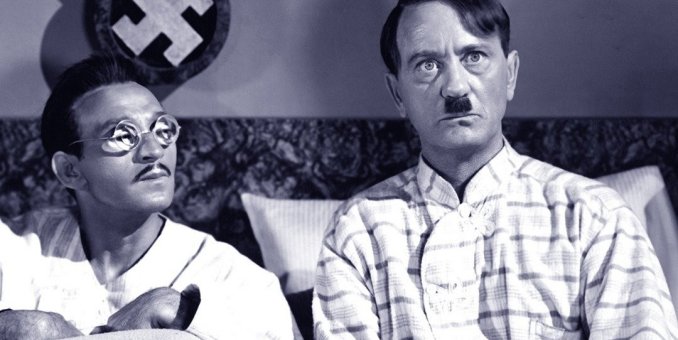
In this Hal Roach comedy, the board of directors of Hell decide that since in their estimation Adolf Hitler is doing such a good job, he should replace Satan as head honcho. In order to protect his job, Satan travels up to Germany and replaces Hitler’s valet with the objective of getting Hitler to do just one good deed, which would make him look bad in front of the board. The Devil With Hitler does qualify as the Hitler-themed comedy with the most unusual premise ever, at least until Taika Waititi’s Jojo Rabbit would come along nearly 80 years later. As this is a Hal Roach comedy, the short is filled with numerous slapstick gags, and may also feature the first time that a Japanese character is painted with the stereotype that the Japanese all carry and constantly use cameras. Roach would follow up The Devil With Hitler with a sequel of sorts, The Nazty Nuisance (1943), also featuring Bobby Watson as Hitler. Ultimately, the actor would appear as Hitler in a total of nine films altogether both during wartime and afterwards – Hitler – Dead or Alive (1942), The Miracle of Morgan’s Creek (1944), The Hitler Gang (1944), A Foreign Affair (1948), The Story of Mankind (1957), On the Double (1961) and Four Horsemen of the Apocalypse (1962). Fortunately, he is perhaps better remembered as the diction coach in the “Moses Supposes” number in 1952’s classic Singin’ In The Rain.
Der Fhurer’s Face
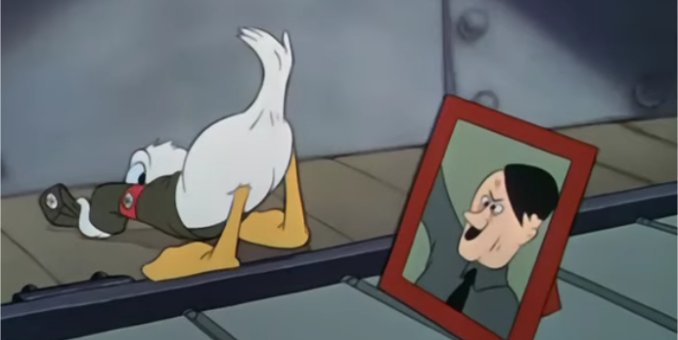
By 1943, the country was fully united in the war effort, with all businesses and industries turning their specialties to what they could do to help defeat the Axis powers. Hollywood’s contributions to this were many – Some filmmakers worked fort he War Department making training films or documenting actual battles while the studios themselves made films that extolled the war effort and vilified the Germans, Italians and Japanese. Walt Disney Studios contributed a number of animated training shorts to the armed forces, but it was one of their star cartoon characters, Donald Duck, who would take the fight to Hitler himself with the animated short Der Fuhrer’s Face. (Popeye was the first cartoon character to enlist into the fight, having already gone to war the previous year with the Japanese in Blunder Below.) In the cartoon, Donald has a nightmare about living under the Third Reich, being forced to slave away in a munitions factory and fighting back in the only way he can. The title song was penned by staff writer Oliver Wallace and a version was recorded and released by musical comedian Spike Jones alongside his band the City Slickers a few months before the cartoon hit theaters, so the public was already familiar with the tune. (Jones’ version would find a new popularity in the 1970s and `80s thanks to repeated airings on the syndicated novelty song program The Dr. Demento Show.) While Disney would see a total of nine Donald Duck shorts get nominated for Academy Awards, Der Fuhrer’s Face would be the only won to actually win an Oscar statuette.
Russian Rhapsody
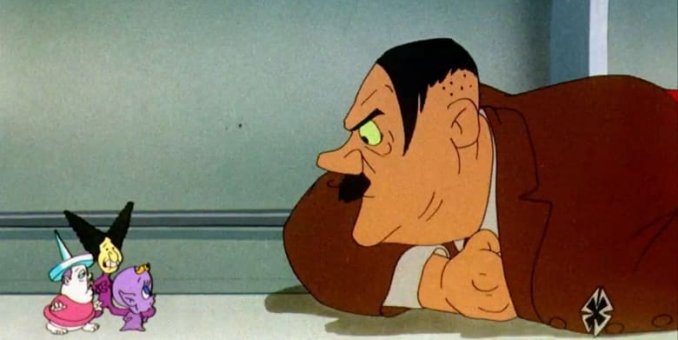
While most cartoon characters were taking up the Allied cause against Hitler and the Third Reich, there was one group that seemed to not take sides – the Gremlins. Bugs Bunny had already faced off against them six months earlier while trying to chase them off an Army Air Force base in director Bob Clampett’s October 1943 short Falling Hare. But here, Clampett sicks the diminutive mischief makers on the Third Reich, systematically having them take apart a German bomber being personally piloted by Hitler on its way to drop bombs on Moscow. As the gremlins – whom many of look suspiciously like members of the Warner Brothers animation department staff – go about their work, they sing a little ditty about being “the Gremlins from the Kremlin” to the tune of “Song of the Volga Boatmen.” It is also interesting to note how pro-Soviet Union/Stalin the premise and execution of the cartoon short is. Russia was a member of the Allies at the time, so American propaganda would of course be portraying the country in a positive light. But it would be just a few years later once the Cold War started that some filmmakers who once touted our country’s alliance with Russia would come under the suspicious gaze of the House Unamerican Activities Committee for alleged communist ties.
Herr Meets Hare
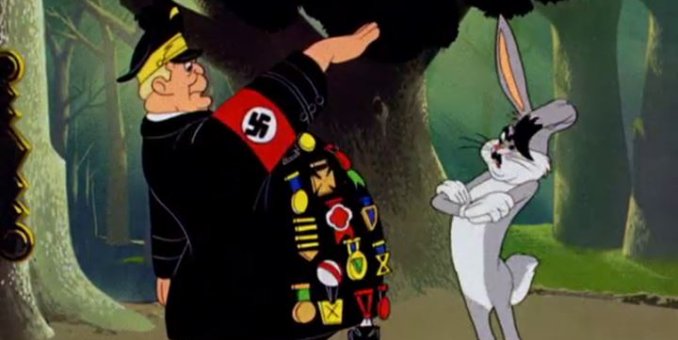
Many cartoon characters went to war in the early 1940s, but if there was any of them to truly represent the US attitude towards the Axis, it could be Bugs Bunny. Brashly anti-authority with a strong disdain for bullies, Bugs was almost destined to take on the Third Reich. And in Herr Meets Hare, he comes face-to-face with Hitler’s right hand man Herman Goring in Germany’s Black Forest. In the midst of Bugs having his usual brand of fun with Goring, he gives himself a Schicklgruber mustache and berates Goring in a stream of ridiculous faux German. With the collapse of the Third Reich just months away from this short’s January 1945 release, Herr Meets Hare would be the second to last wartime cartoon produced by Warner Brothers. But it is more significant for two other reasons. Animation scholars point to the use of the music of German opera composer Richard Wagner and a segment of the cartoon where Bugs is in drag as Brünnhilde from German folklore as precursors to the iconic 1957 Bugs Bunny short What’s Opera, Doc?. Not uncoincidentally, Michael Maltese wrote both shorts. Also, this cartoon featured the addition of a new catchphrase to Bugs’ arsenal, “I knew I shoulda taken that left turn at Albakoikie.”
The Producers
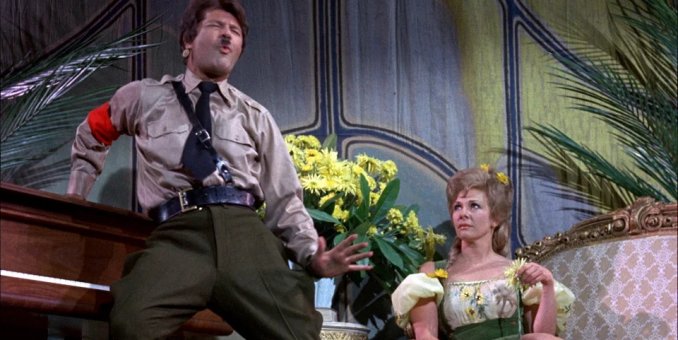
It is often said that comedy equals tragedy plus time, but with The Producers Mel Brooks was pushing that idea to its limits. When the the writer/director brought his farce about two Broadway producers looking to scam lonely widows into investing in a terrible musical about the Fuhrer, Germany’s surrender was only about 22 years in the last but still very fresh in many people’s minds. (To put the time frame into perspective, imagine someone putting out a comedy about Osama bin Laden and 9/11 today.) To some, the idea may have been seen in bad taste, and within the film that is what Brooks’ protagonists were counting on. However, once the film opened and people saw how Brooks’ musical-within-the-movie, Springtime For Hitler, was being presented, they laughed as hard as the Broadway audience in the film itself. And it may have just allowed for a collective, cathartic release that people needed after the war years.




